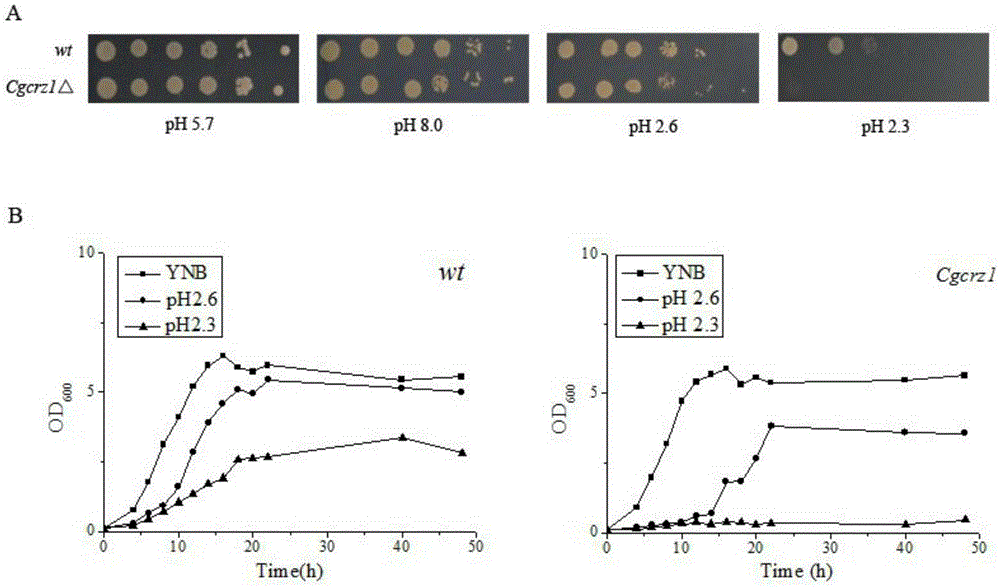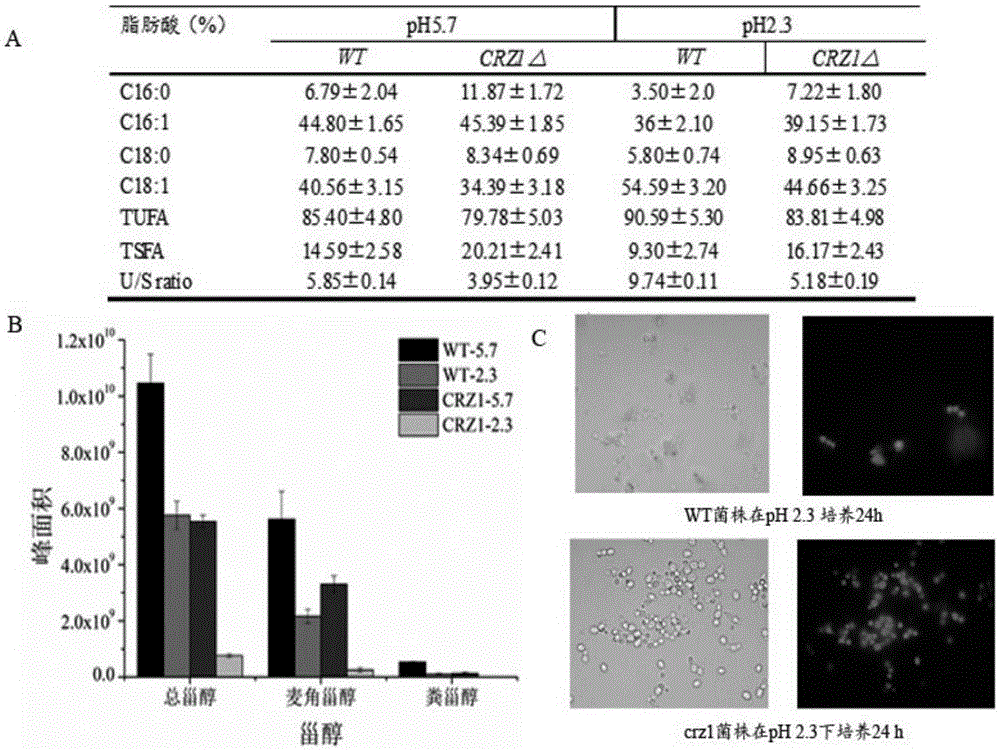Method for regulating acid stress resistance of torulopsis glabrata by utilizing transcription factor Crz1p
A technology of acid stress of Toroplasma glabrata, which is applied in the field of regulating acid stress resistance of Toroplasma glabrata, and can solve problems that have not been widely carried out
- Summary
- Abstract
- Description
- Claims
- Application Information
AI Technical Summary
Problems solved by technology
Method used
Image
Examples
Embodiment 1
[0025] Example 1: Construction of Deletion Mutants
[0026] Using the C.glabrataATCC2001 (wt) genome as a template, P1 / P2 (sequences are shown in SEQIDNO:1 and SEQIDNO:2), P3 / P4 (sequences are respectively shown in SEQIDNO:3 and SEQIDNO:4), P5 / P6 (sequence shown in SEQIDNO:5, SEQIDNO:6 respectively) is a primer, amplifies the left arm (L), histidine gene (M) and right arm (R) of the gene to be knocked out, and undergoes fusion PCR Construction of the knockout box CgCRZ1-LMR ( figure 1 ). The starting strain C.glabrataATCC55 cannot grow on MM screening medium due to the deletion of histidine gene, while the mutant strain can grow on MM medium due to the expression of marker gene histidine after homologous recombination. Perform PCR verification on transformants, such as figure 1 As shown, the genome of the transformant was extracted, and it was found that when using P7 / P8 (sequences shown in SEQIDNO:7 and SEQIDNO:8) as primers, the wild-type strain wt produced a gene fragme...
Embodiment 2
[0035] Embodiment 2: Determination of growth performance of deletion mutant bacteria
[0036] Functional characterization of CgCRZ1 by plate growth assays and cell growth assays:
[0037] 1) Plate growth experiment:
[0038] Inoculate a single colony of the strain to be tested in 20 mL of YNB (0.67% YeastNitrogenBasewithoutAminoAcids, 2% Glucose, pH 5.7) liquid medium, culture on a shaker at 30°C for 12h to the logarithmic growth phase, measure the concentration of the bacteria and suspend the bacteria. Liquid adjusted to OD 600 = 1.0, using this as the initial concentration, carry out 5 times of 10-fold gradient dilution, inoculate 4 μ L of the bacterial liquid on the solid medium to be tested in turn, cultivate at 30°C for 2 days, observe the growth of the bacterial cells and take pictures.
[0040] Inoculate the strain to be tested in the logarithmic phase into 20 mL of YNB (0.67% YeastNitrogenBasewithoutAminoAcids, 2% Glucose, pH5.7) liqui...
Embodiment 3
[0042] Example 3: Determination of cell membrane properties of deletion mutant bacteria
[0043] The cell membrane properties of Toruula glabrata were evaluated by measuring cell membrane fatty acid and cell membrane permeability.
[0044] (1) Cell membrane fatty acid determination
[0045] Cell culture: Yeast cells treated with YNB-5.7 and YNB-2.3 for 12 hours were collected, washed three times with PBS buffer, and then freeze-dried before use. Lipid extraction and treatment: Weigh 30 mg of freeze-dried cells, place in a test tube, add 1 ml of solution I, and conduct a water bath at 100°C for 30 minutes. Use an ice bath to rapidly cool down, then add 2mL of solution II, mix well and treat in a water bath at 80°C for 5min. Cool rapidly, and add 1.25 mL of solution III. Shake well for 5 minutes, then keep the upper layer solution. Then add 3ml of solution IV and a few drops of saturated sodium chloride solution to the upper layer solution, and shake for 5 minutes. Stand st...
PUM
 Login to View More
Login to View More Abstract
Description
Claims
Application Information
 Login to View More
Login to View More - R&D
- Intellectual Property
- Life Sciences
- Materials
- Tech Scout
- Unparalleled Data Quality
- Higher Quality Content
- 60% Fewer Hallucinations
Browse by: Latest US Patents, China's latest patents, Technical Efficacy Thesaurus, Application Domain, Technology Topic, Popular Technical Reports.
© 2025 PatSnap. All rights reserved.Legal|Privacy policy|Modern Slavery Act Transparency Statement|Sitemap|About US| Contact US: help@patsnap.com



